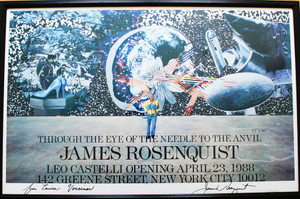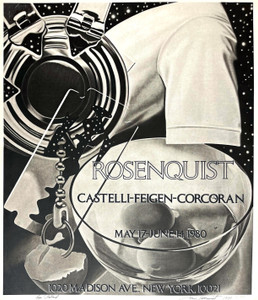
James Rosenquist, Nails, from Monochromes at the New Gallery, 1975
James RosenquistCONTACT GALLERY FOR PRICE
James Rosenquist
Nails, from Monochromes at the New Gallery, 1975
Limited edition lithograph and offset lithograph (pencil signed and numbered)
Signed and numbered 10/100 in graphite pencil on the front
20 × 28 inches
Unframed
Rare 1970s limited edition lithograph and offset lithograph published on the occasion of the historic exhibition of Rosenquists monochromes; the image depicted is "Nails"
Pencil signed and numbered 10/100 on the front
The New Gallery in fact, is the original name for MOCA Cleveland. MoCa Cleveland was founded in 1968 by Marjorie Talalay, Nina Castelli Sundell and Agnes Gund as The New Gallery to showcase contemporary art and introduce it to Clevelanders with the works of cutting edge artists such as Christo, Jasper Johns, Laurie Anderson, Andy Warhol and of course James Rosenquist.
Publisher
The New Gallery, Cleveland, Ohio
James Rosenquist Biography
James Rosenquist (November 29, 1933 – March 31, 2017) became well known in the 1960s as a leading American Pop artist alongside contemporaries Andy Warhol, Roy Lichtenstein, Claes Oldenburg, and other figurative artists. As with his contemporaries, Rosenquist’s background in commercial art deeply influenced his nascent fine-art career and radically changed the face of the art world and the annals of art history. While each Pop artist developed a distinct style, there were commonalities in their approaches to image-making that helped define the Pop art movement in the early 1960s: the use of commercial art techniques, and the depiction of popular imagery and everyday objects.
Drawing on his early experience as a billboard painter, Rosenquist culled imagery from print advertisements, photographs, and popular periodicals and recombined these to create mysterious and bold compositions. Utilizing the visual language of advertising, described by the late American curator Walter Hopps as "visual poetry," his work has plumbed questions ranging from the economic, romantic, and ecological to the scientific, cosmic and existential. Creating seminal new work over more than five decades, Rosenquist consistently expressed facile talent in painting, collage, drawing, and printmaking. His work is included in major public and private institutions, and has been featured in solo exhibitions at the Solomon R. Guggenheim Museum, Museum of Modern Art, Walker Art Center, Whitney Museum of American Art, Guggenheim Museum Bilbao, The Menil Collection, The Museum of Fine Arts Houston, Denver Art Museum, Tretyakov Gallery, Museum Ludwig, Wallraf-Richartz Museum, and other national and international institutions.









